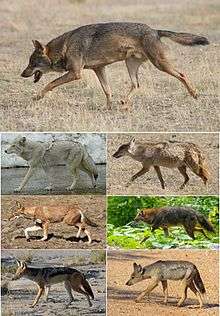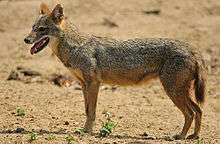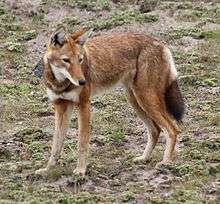Canis
| Canis Temporal range: Miocene to Recent 9–0 Ma | |
|---|---|
 | |
| Grey wolf (top), coyote and African golden wolf (top middle), Ethiopian wolf and golden jackal (bottom middle), black-backed jackal and side-striped jackal (bottom) | |
| Scientific classification | |
| Kingdom: | Animalia |
| Phylum: | Chordata |
| Class: | Mammalia |
| Order: | Carnivora |
| Suborder: | Caniformia |
| Family: | Canidae |
| Tribe: | Canini |
| Genus: | Canis Linnaeus, 1758[2] |
| Extant Species | |
|
1 C. lupus also includes domestic dogs, C. l. familiaris and dingos, C. l. dingo | |
Canis is a genus of canids containing multiple extant species. Species of this genus are distinguished by their moderate to large size, their massive, well developed skulls and dentition, long legs, and comparatively short ears and tails.[3]
Etymology
The generic name Canis means "dog" in Latin. The term "canine" comes from the adjective form, caninus ("of the dog"), from which the term canine tooth is also derived.[4] The canine family has prominent canine teeth, used for killing their prey. The word canis is cognate to the Greek word kūon (Greek: Κύων) which means "dog".
Terminology
- In common terminology, an adult male is called by the species' common name: dog, wolf, jackal, etc.
- An adult female is a bitch. In some countries, especially in North America, bitch rarely is used due to its vulgar connotation; the species' common name is more pervasive.
- An adult male capable of reproduction is a stud.
- An adult female capable of reproduction is a brood bitch, or brood mother.
- Immature males or females (that is, animals that are incapable of reproduction) are pups or puppies.
- A group of pups from the same gestation period is a litter.
- The father of a litter is a sire. It is possible for one litter to have multiple sires.
- The mother of a litter is a dam.
- A group of any three or more adult canids is a pack.
Taxonomy
Canini
The tribe Canini[5] (Fischer de Waldheim, 1817) is the sister group to the foxes (vulpes), and is represented today by two sub-tribes: genus Canis[6] that includes dogs, wolves, coyotes, jackals; and the genus Cerdocyonina[7] that includes the so-called foxes of South America (Crab-eating fox). The critical features that mark the Canini as a monophyletic group include: the consistent enlargement of the frontal sinus, often accompanied by the correlated loss of the depression in the dorsal surface of the postorbital process; the posterior expansion of the paroccipital process; the enlargement of the mastoid process; and the lack of lateral flare of the orbital border of the zygoma.[8]:p77
Canis
The genus Canis (Carl Linnaeus, 1758) was published in the 10th edition of Systema Naturae[2] and included the dog-like carnivores: the domestic dog, wolves, coyotes and jackals. All species within the Canis genus are phylogenetically closely related with 78 chromosomes and can potentially interbreed.[9]
Evolution
The fossil record shows that Feliforms and Caniforms emerged within the super-family Carnivoramorpha 43 million YBP.[10] The caniforms included the fox-like Leptocyon genus whose various species existed from 34 million YBP before branching 11.9 million YBP into vulpes (foxes) and canini (canines). The jackal-sized Eucyon existed in North America from 10 million YBP and by the Early Pliocene about 6-5 million YBP the coyote-like Eucyon davisi[11] invaded Eurasia. In North America it gave rise to early Canis which first appeared in the Miocene (6 million YBP) in south-western USA and Mexico. By 5 million YBP the larger Canis lepophagus appeared in the same region.[12]:p58
The canids that had emigrated from North America to Eurasia – Eucyon, Vulpes, and Nyctereutes – were small to medium-sized predators during the Late Miocene and Early Pliocene but they were not the top predators. The position of the canids would change with the arrival of Canis to become a dominant predator across the Holarctic. The wolf-sized C. chihilensis appeared in northern China in the Mid-Pliocene around 4-3 million YBP. This was followed by an explosion of Canis evolution across Eurasia in the Early Pleistocene around 1.8 million YBP in what is commonly referred to as the Wolf event. It is associated with the formation of the Mammoth steppe and continental glaciation. Canis spread to Europe in the forms of C. arnensis, C. eutruscus, and C. falconeri.[12]:p148 One study found that the diversity of the Canis group decreased by the end of the Early Pleistocene to Middle Pleistocene and was limited in Eurasia to the small wolves of the Canis mosbachensis–Canis variabilis group and the large hypercarnivorous Canis (Xenocyon) lycaonoides.[13]
- See further: Evolution of the canids
Wolves, dogs and dingoes
| The extant wolf-like canids | |||||||||||||||||||||||||||||||||||||||||||||||||||||||||||||||
| |||||||||||||||||||||||||||||||||||||||||||||||||||||||||||||||
| Phylogenetic relationships between the extant wolf-like clade of canids.[14][15] See further:Canid relationships |
Wolves, dogs, and dingoes are subspecies of Canis lupus. The original referent of the English word wolf, the Eurasian wolf, is called C. l. lupus to distinguish it from other wolf subspecies, such as the Indian wolf (C. l. pallipes), the Arabian wolf (C. l. arabs), or the Tibetan wolf (C. l. chanco).
Some experts have suggested some subspecies of C. lupus be considered Canis species distinct from C. lupus. These include Central Asia's Himalayan wolf, and the Indian wolf,[16][17] as well as the North America's red wolf and eastern wolf.[18]
The dingo (C. l. dingo), from Australasia, and the domestic dog (C. l. familiaris) are also considered subspecies of C. lupus, although they are not commonly referred to or thought of as "wolves".[19]
Coyotes, jackals, and wolves
The Gray wolf (C. lupus), the Ethiopian wolf (C. simensis), and the African golden wolf (C. anthus) are three of the many Canis species referred to as "wolves"; however, all of the others are now extinct and little is known about them by the general public. One of these, the extinct dire wolf (C. dirus), has gained fame from the thousands of specimens found and displayed at the Rancho La Brea Tar Pits in Los Angeles, California.
Canis species that are too small to attract the word "wolf" are called coyotes in the Americas and jackals elsewhere. Although these may not be more closely related to each other than they are to C. lupus, they are, as fellow Canis species, all more closely related to wolves and domestic dogs than they are to foxes, maned wolves, or other canids which do not belong to the genus Canis. The word "jackal" is applied to three distinct species of this group: the side-striped (C. adustus) and black-backed (C. mesomelas) jackals, found in sub-Saharan Africa, and the golden jackal (C. aureus), found across southwestern and south-central Asia, and the Balkans.
While North America has only one small-sized species, the coyote (C. latrans), it has become very widespread, moving into areas once occupied by wolves. They can be found across much of mainland Canada, in every state of the contiguous United States, all of Mexico except the Yucatán Peninsula, and the Pacific and central areas of Central America, ranging as far as western Panama.
African migration

In 2015, a study of mitochondrial genome sequences and whole genome nuclear sequences of African and Eurasian canids indicated that extant wolf-like canids have colonised Africa from Eurasia at least 5 times throughout the Pliocene and Pleistocene, which is consistent with fossil evidence suggesting that much of African canid fauna diversity resulted from the immigration of Eurasian ancestors, likely coincident with Plio-Pleistocene climatic oscillations between arid and humid conditions. When comparing the African and Eurasian golden jackals, the study concluded that the African specimens represented a distinct monophyletic lineage that should be recognized as a separate species, Canis anthus (African golden wolf). According to a phylogeny derived from nuclear sequences, the Eurasian golden jackal (Canis aureus) diverged from the wolf/coyote lineage 1.9 million years ago but the African golden wolf separated 1.3 million years ago. Mitochondrial genome sequences indicated the Ethiopian wolf diverged from the wolf/coyote lineage slightly prior to that.[20]:S1
Gallery

.jpg) Eastern wolf (Canis lycaon) (often includes latrans admixture)
Eastern wolf (Canis lycaon) (often includes latrans admixture).jpg) Red wolf (Canis rufus) (includes latrans admixture)
Red wolf (Canis rufus) (includes latrans admixture) Coyote (Canis latrans)
Coyote (Canis latrans) Dire wolf (Canis dirus) (extinct)
Dire wolf (Canis dirus) (extinct) African golden wolf (Canis anthus)
African golden wolf (Canis anthus) Golden jackal (Canis aureus)
Golden jackal (Canis aureus) Ethiopian wolf (Canis simensis)
Ethiopian wolf (Canis simensis) Black-backed jackal (Canis mesomelas)
Black-backed jackal (Canis mesomelas)-_rare_sighting_of_this_nocturnal_animal_..._(13799182833).jpg) Side-striped jackal (Canis adustus)
Side-striped jackal (Canis adustus)
See also
References
| Wikispecies has information related to: Canis |
- ↑ Canis Linnaeus 1758 in The Palaeobiology Database
- 1 2 Linnæus, Carl (1758). Systema naturæ per regna tria naturæ, secundum classes, ordines, genera, species, cum characteribus, differentiis, synonymis, locis. Tomus I (in Latin) (10th ed.). Holmiæ (Stockholm): Laurentius Salvius. p. 38. Retrieved November 23, 2015.
- ↑ Heptner, V. G.; Naumov, N. P. (1998). Mammals of the Soviet Union Vol.II Part 1a, SIRENIA AND CARNIVORA (Sea cows; Wolves and Bears). Science Publishers, Inc. USA. pp. 124-129. ISBN 1-886106-81-9.
- ↑ Harper, Douglas. "canine". Online Etymology Dictionary.
- ↑ Fossilworks website Canini
- ↑ Fossilworks website Canis
- ↑ Fossilworks website Cerdocyonina
- ↑ Tedford, R (2009). "Phylogenetic Systematics of the North American Fossil Caninae (Carnivora: Canidae)". Bulletin of the American Museum of Natural History. 325: 1–218. doi:10.1206/574.1.
- ↑ Wayne, R. (1999). "Origin, genetic diversity, and genome structure of the domestic dog". BioEssays. 21 (3): 247–57. doi:10.1002/(SICI)1521-1878(199903)21:3<247::AID-BIES9>3.0.CO;2-Z. PMID 10333734.
- ↑ Flynn, John J.; Wesley-Hunt, Gina D. (2005). "Phylogeny of the Carnivora: Basal Relationships Among the Carnivoramorphans, and Assessment of the Position of 'Miacoidea' Relative to Carnivora". Journal of Systematic Paleontology. 3: 1–28.
- ↑ Fossilworks website Eucyon davisi
- 1 2 Wang, Xiaoming; Tedford, Richard H.; Dogs: Their Fossil Relatives and Evolutionary History. New York: Columbia University Press, 2008. ISBN 9780231135283
- ↑ Sotnikova, M (2010). "Dispersal of the Canini (Mammalia, Canidae: Caninae) across Eurasia during the Late Miocene to Early Pleistocene". Quaternary International. 212 (2): 86–97. doi:10.1016/j.quaint.2009.06.008.
- ↑ Lindblad-Toh, K.; Wade, C. M.; Mikkelsen, T. S.; Karlsson, E. K.; Jaffe, D. B.; Kamal, M.; Clamp, M.; Chang, J. L.; Kulbokas, E. J.; Zody, M. C.; Mauceli, E.; Xie, X.; Breen, M.; Wayne, R. K.; Ostrander, E. A.; Ponting, C. P.; Galibert, F.; Smith, D. R.; Dejong, P. J.; Kirkness, E.; Alvarez, P.; Biagi, T.; Brockman, W.; Butler, J.; Chin, C. W.; Cook, A.; Cuff, J.; Daly, M. J.; Decaprio, D.; et al. (2005). "Genome sequence, comparative analysis and haplotype structure of the domestic dog". Nature. 438 (7069): 803–819. Bibcode:2005Natur.438..803L. doi:10.1038/nature04338. PMID 16341006.
- ↑ Koepfli, K.-P.; Pollinger, J.; Godinho, R.; Robinson, J.; Lea, A.; Hendricks, S.; Schweizer, R. M.; Thalmann, O.; Silva, P.; Fan, Z.; Yurchenko, A. A.; Dobrynin, P.; Makunin, A.; Cahill, J. A.; Shapiro, B.; Álvares, F.; Brito, J. C.; Geffen, E.; Leonard, J. A.; Helgen, K. M.; Johnson, W. E.; O’Brien, S. J.; Van Valkenburgh, B.; Wayne, R. K. (2015-08-17). "Genome-wide Evidence Reveals that African and Eurasian Golden Jackals Are Distinct Species". Current Biology. 25 (16): 2158–65. doi:10.1016/j.cub.2015.06.060. PMID 26234211.
- ↑ Aggarwal, R. K.; Kivisild, T.; Ramadevi, J.; Singh, L. (2007). "Mitochondrial DNA coding region sequences support the phylogenetic distinction of two Indian wolf species" (PDF). Journal of Zoological Systematics and Evolutionary Research. 45 (2): 163–172. doi:10.1111/j.1439-0469.2006.00400.x.
- ↑ Jhala, Y.; Sharma, D. K. (2004). "The Ancient Wolves of India" (PDF). International Wolf. 14 (2): 15–16. Archived from the original (PDF) on 2009-04-21.
- ↑ Chambers SM, Fain SR, Fazio B, Amaral M (2012). "An account of the taxonomy of North American wolves from morphological and genetic analyses". North American Fauna. 77: 1–67. doi:10.3996/nafa.77.0001.
- ↑ Wilson, D.E.; Reeder, D.M., eds. (2005). "Genus Canis". Mammal Species of the World: A Taxonomic and Geographic Reference (3rd ed.). Johns Hopkins University Press. ISBN 978-0-8018-8221-0. OCLC 62265494.
- ↑ Koepfli, Klaus-Peter; Pollinger, John; Godinho, Raquel; Robinson, Jacqueline; Lea, Amanda; Hendricks, Sarah; Schweizer, Rena M.; Thalmann, Olaf; Silva, Pedro; Fan, Zhenxin; Yurchenko, Andrey A.; Dobrynin, Pavel; Makunin, Alexey; Cahill, James A.; Shapiro, Beth; Álvares, Francisco; Brito, José C.; Geffen, Eli; Leonard, Jennifer A.; Helgen, Kristofer M.; Johnson, Warren E.; o'Brien, Stephen J.; Van Valkenburgh, Blaire; Wayne, Robert K. (2015). "Genome-wide Evidence Reveals that African and Eurasian Golden Jackals Are Distinct Species". Current Biology. 25 (16): 2158. doi:10.1016/j.cub.2015.06.060. PMID 26234211.